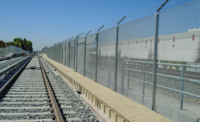“In the old days, we would hire a security guard at the door of every clean room so no one would go in,” says Osman Chao, project executive at DPR Construction, who recently adopted Trimble’s ThingMagic, a radio-frequency identification (RFID) system that has replaced the guards at egress points and helped automate his site security.
Before the job began, Chao was faced with securing a 900,000-sq-ft site with many work zones and four phases of building protocol in which the level of cleanliness would increase with each phase. “Cleanliness isn’t a big issue when we’re building up the structure, but the minute the building is closed in and we’re building out the interiors, we need to make sure we regulate what gets into certain areas,” says Chao.
Chao put out a job order, and three RFID vendors responded with bids. A few of the things Chao wanted were real-time visibility into worker location during evacuation and instant alerts on safety and security breaches. He says that, beyond providing these options, a few key things made ThingMagic’s bid stand out from the others.
“They had BIM integration, which no other vendor offered,” says Chao. He adds that one other vendor was offering a battery-powered, active-tag system, but those tags were 20 times more expensive. "[ThingMagic’s] system has passive ID tags, meaning they aren’t battery-powered—they’re just like ID badges,” he says.
When the RFID badges get within three to 10 meters of a sensor, the sensor indicates whether or not the worker should be there. Aside from saving on security-worker costs, he used RFID in case one of the zones needed to be locked down or evacuated, so his company could have a head count from zone to zone, he says.
Chao has used Trimble's total stations before, which is another reason he chose the system. “They really understood our business better than the other vendors because they have a construction division and understand our struggles as a construction company,” says Chao. He is still in the process of computing all the collected data but already has used the data to monitor and improve subcontractor performance.
“If the progress of a floor is behind and they’re misallocating a workforce or misplaced materials that could be in a better area for other subs, we can see that and help them out,” Chao notes.






